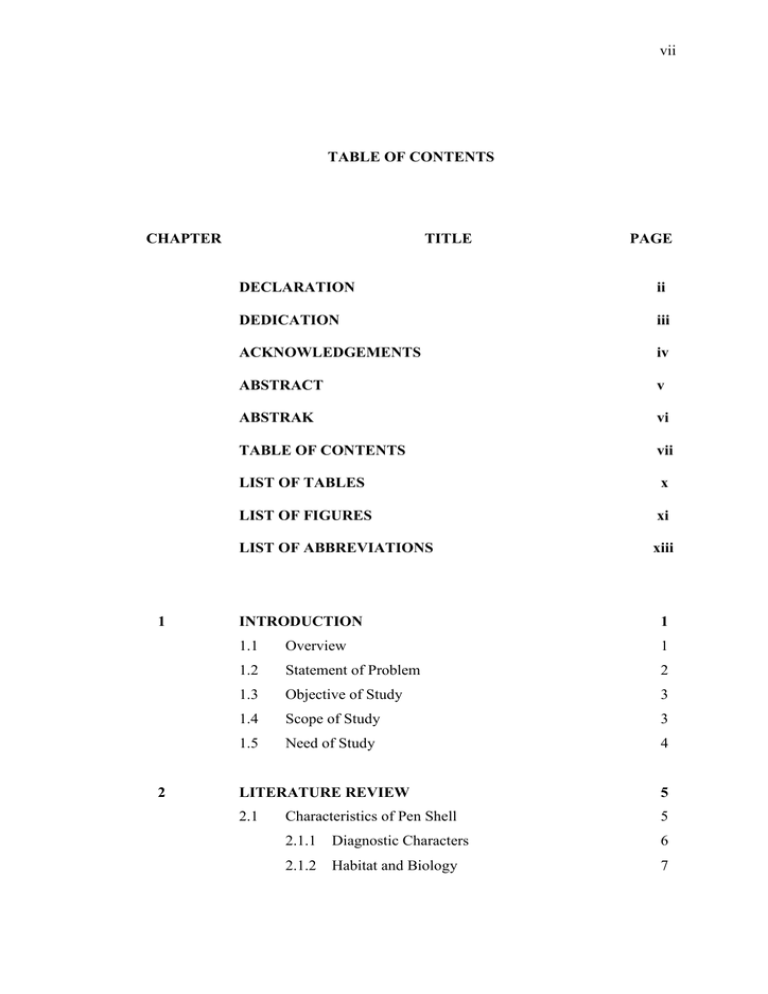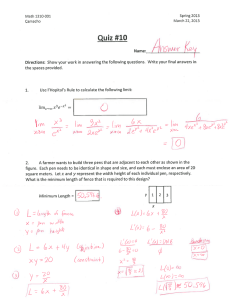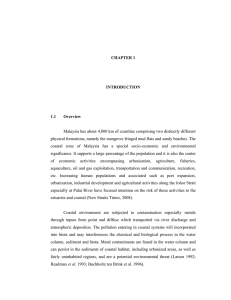vii TABLE OF CONTENTS CHAPTER
advertisement

vii TABLE OF CONTENTS CHAPTER 1 2 TITLE PAGE DECLARATION ii DEDICATION iii ACKNOWLEDGEMENTS iv ABSTRACT v ABSTRAK vi TABLE OF CONTENTS vii LIST OF TABLES x LIST OF FIGURES xi LIST OF ABBREVIATIONS xiii INTRODUCTION 1 1.1 Overview 1 1.2 Statement of Problem 2 1.3 Objective of Study 3 1.4 Scope of Study 3 1.5 Need of Study 4 LITERATURE REVIEW 5 2.1 Characteristics of Pen Shell 5 2.1.1 Diagnostic Characters 6 2.1.2 Habitat and Biology 7 viii 2.2 Source of Food 10 2.3 Distribution of Pen Shell 11 2.4 Physical Water Quality Parameter 14 2.4.1 Total Suspended Solid 14 2.4.2 Turbidity 15 2.4.3 Temperature 16 2.4.4 Salinity 17 Chemical Water Quality Parameter 18 2.5.1 Dissolved Oxygen 18 2.5.2 Biological Oxgyen Demand 19 2.5.3 Chemical Oxygen Demand 20 2.5.4 pH 21 2.5.5 Nutrients 23 2.5 2.5.5.1 Phosphorus 23 2.5.5.2 Ammoniacal Nitrogen 24 2.5.6 Metals 25 2.5.6.1 Arsenic 25 2.5.6.2 Cadmium 26 2.5.6.3 Chromium 27 2.5.6.4 Copper 28 2.5.6.5 Lead 29 2.5.6.6 Mercury 29 2.5.6.7 Nickel 31 2.5.6.8 Iron 32 2.5.6.9 Manganese 32 2.5.6.10Zinc 33 2.5.7 Oil and Grease 34 2.6 Marine Pollution 35 2.7 Impact of Heavy Metals in Marine System 35 2.8 Marine Water Quality Standard 37 2.8.1 Malaysian Interim Marine Water Quality Standard 2.9 37 2.8.2 Singapore Marine Water Quality Criteria 38 Marine Water Quality Standard 39 ix 2.9.1 Food and agriculture Organization and World Health Organization Standard 3 METHODOLOGY 41 3.1 Introduction 41 3.2 Study Area 41 3.3 Sampling Method 47 3.3.1 Specimen Collections and Identification 47 3.3.2 Pen Shell Sample 49 3.3.3 Water Sample 51 3.4 3.5 4 39 3.3.3.1 Grab Sample 52 3.3.3.2 Sample Preservation 52 3.3.3.3 Chemical Changes 53 3.3.3.4 Biological Changes 53 Chemical Analysis 53 3.4.1 Metal Testing 55 3.4.3.1 Spectrometer Analysis ICP-MS 57 3.4.3.2 Manual of ICP-MS 58 3.4.3.3 ICP-MS Advantages 58 Data Analysis 59 RESULT AND DISCUSSION 60 4.1 Distribution of Pen Shells 60 4.2 Species Identification 62 4.3 Water Quality Analysis 66 4.3.1 Ammoniacal Nitrogen 66 4.3.2 Salinity 67 4.3.3 Oil and Grease 67 4.3.4 Total Suspended Solid 68 4.4 Heavy Metal in Water 70 4.5 Heavy Metal in Pen Shells 73 x 5 CONCLUSION AND RECOMMENDATION 77 5.1 Conclusion 77 5.2 Recommendation 78 REFERENCES 79 1 LIST OF TABLES TABLE NO. 2.1 TITLE PAGE Description of taxonomic diffrences of pen shell (Idris, 2008) 9 Malaysia Interim Marine Water Quality Standard (DOE, 2004) 38 2.3 Summary of Criteria for Site Selection for floating 39 2.4 Maximum Limit for Metal in Bivalve Mollusks 40 3.1 Analytical Procedures (Standard Method American Public Health Association) 54 4.1 List of Pen Shells Species in the study area 60 4.2 Pen shells Identification at study areas 64 4.3 Water Quality Result at Merambong Island and Merambong Seagrss Shoal 69 Heavy Metal Concentration in Water Samples collected from the Merambong Island and Merambong Shoal 72 Heavy Metal Concentration in Pen shells (Pinnidae) 76 2.2 4.4 4.5 2 LIST OF FIGURES FIGURE NO. TITLE PAGE 2.1 Pen shells species in Pulai River 8 2.2 Pen shells or Tairagi in Japanese 11 2.3 Pen shells locally know as “siput kemudi” in Malaysia 11 2.4 Distribution recorded of Pen shell at surrounnding water of Peninsular Malaysia in 1973-1974 13 2.5 Phosphorus inputs, outputs and transformation (Porter, 1975) 24 3.1 Map showing the study area, Merambong Island (A) and Merambong Seagrass Shoal (B) 43 3.2 Study Area 43 3.3 Merambong Island reduced water 160 m during low tide 44 3.4 Station 1 for water quality at Merambong Island, 180m from Island 45 3.5 Station 2, 130m from from Merambong Island 45 3.6 Station 3 at Merambong Seagrass Shoal, 1.5km from PTP 46 3.7 Station 4 at Merambong Seagrass Shoal, 1 km from Merambong Island 46 3.8 Pen Shell around Merambong Island in soft sediment 47 3.9 Pen shell at sandy substrate of the Merambong Seagrass Shoal 47 3.10 Geographical Positioning System was used to determine Coordinate and distance 48 Pen shell found at Merambong Island 48 3.11 3 3.12 Specimen of Pen shells were collected by using hand scooped 49 3.13 Soft tissues in Pen shell 50 3.14 The tissues samples were weighted (1g) 51 3.15 Sample digested using an open beaker digestion technique on hot plate 51 3.16 Grab Sampling 52 3.17 Measuring pH via Consort 535 Analyzer and YSI 55 Probe for Dissolved Oxygen 55 3.18 HACH DR 5000 Spectrophotometer 55 3.19 ICP-MS Manual Working Principles Scheme 57 3.20 Inductively Coupled Plasma Mass Spectrometer (ICP-MS) 59 4.1 Number of Individual present for every collection area 61 4.2 The difference between Atrina and Pinna (Idris, 2008) 63 4.3 Mean Concentration of heavy metals Arsenic (a), Copper (b) And Mercury (c) in water from four stations in Merambong Island and Merambong Seagrass Shoal 71 Heavy Metal Concentration in Pen Shells (a)P.bicolor (b)P.deltodes, (c)P.atropurpurea and (d)A.vexillium at Merambong Island and Merambong Seagrass Shoal 75 4.4 4 LIST OF SYMBOLS AMWQC ASEAN Marine Water Quality Criteria APHA American Public Health Association As Arsenic BOD Biochemical Oxygen Demand Cd Cadminium Cu Copper COD Chemical Oxygen Demand Cr Chromium DO Dissolved Oxygen DOE Department of Environmental FAO Food and Agriculture Organization Fe Iron Hg Mercury IMWQS Malaysia Interim Marine Water Quality Standards Mn Manganese Ni Nickel Pb Lead SMWQC Singapore Marine Water Quality Criteria TSS Total suspended solid UTM Universiti Teknologi Malaysia WHO World Health Organization Zn Zinc




